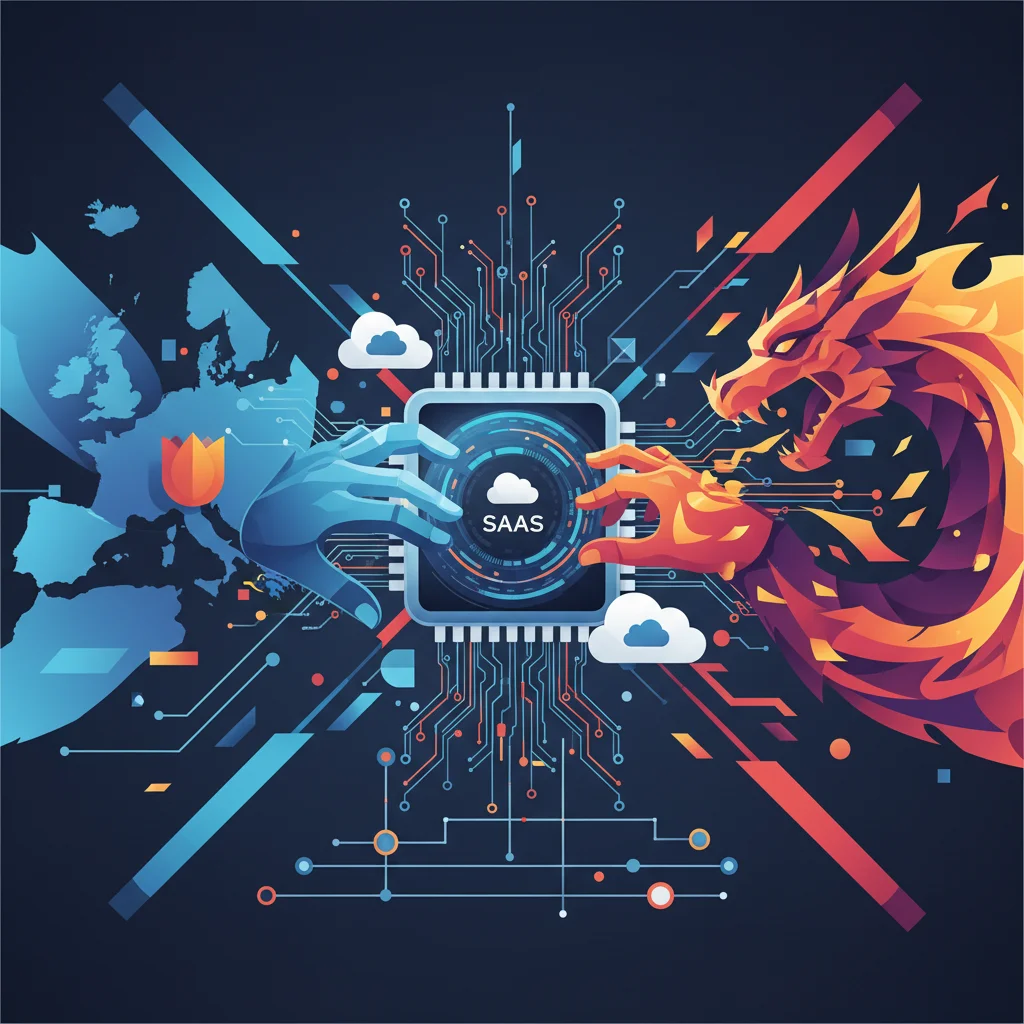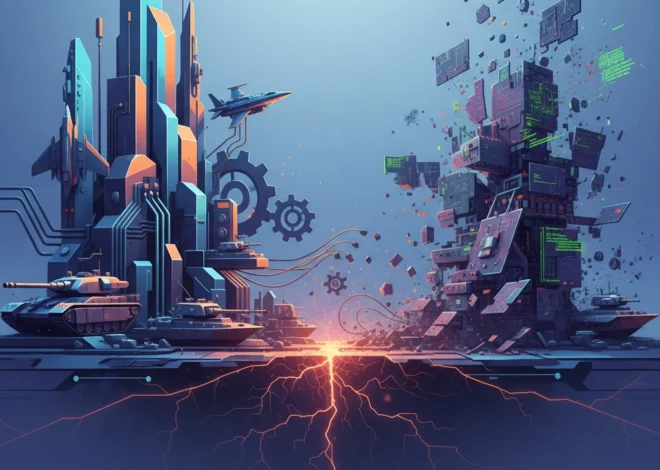
The New Cold War is Fought with Silicon: Why a Dutch Chip Firm Takeover Signals a Global Tech Showdown
In the world of technology, we often celebrate the elegant lines of code, the intuitive user interfaces, and the transformative power of software. We talk about the cloud, the rise of intelligent SaaS platforms, and the incredible potential of artificial intelligence. But beneath every single one of these digital marvels lies a physical foundation, a tiny, intricate piece of silicon that is quickly becoming the most contested resource on the planet: the semiconductor chip.
Recently, an event that might have otherwise been a footnote in the business pages sent a shockwave through the global tech community. The Dutch government stepped in to block the acquisition of a local chip startup, Nowi, by Nexperia, a Dutch company owned by the Chinese tech firm Wingtech. According to the BBC, this unprecedented move was made on the grounds of national security, aiming to protect vital technology supplies.
This isn’t just a corporate deal gone sour. It’s a clear signal that the gloves are off in the global battle for technological supremacy. What happened in the Netherlands is a microcosm of a much larger geopolitical struggle, one that has profound implications for every developer, startup founder, and tech professional. To understand the future of innovation, we need to understand the war being fought over its most fundamental building block.
What’s the Big Deal? Unpacking the Nowi-Nexperia Standoff
At first glance, the companies involved might not seem like household names. Nexperia is a major manufacturer of basic semiconductors, but its parent company, Wingtech Technology, is based in Shanghai. The target, Nowi, is a small Dutch startup specializing in a fascinating niche: energy-harvesting power management chips. These chips are designed to power devices by scavenging energy from their surroundings, like light, heat, or radio waves.
Why would this seemingly innocuous technology trigger a national security alarm? The answer lies in the concept of “dual-use” technology. While Nowi’s chips are perfect for consumer Internet of Things (IoT) devices, their ability to create self-powered sensors and electronics also has significant military and intelligence applications. Imagine tiny, long-lasting sensors that never need a battery change, deployed for surveillance or in advanced weaponry. This potential, coupled with the technology’s origin within a key European tech hub, made the acquisition a red line for the Dutch government.
This intervention is part of a much broader trend. Western governments are increasingly viewing the semiconductor supply chain not just as an economic asset, but as a critical national security infrastructure. As a report by the Center for Strategic and International Studies (CSIS) highlights, the U.S. has already implemented sweeping controls to restrict China’s access to advanced AI chips and manufacturing equipment, a strategy aimed at slowing its military and technological advancement.
The Fragile Global Supply Chain: A House of Cards
For decades, the tech industry has thrived on a globalized supply chain. A chip might be designed in California, fabricated in Taiwan using equipment from the Netherlands, and then assembled and tested in Malaysia before being installed in a device sold in Germany. This system delivered incredible efficiency and drove down costs, fueling the digital revolution.
However, the pandemic and rising geopolitical tensions have exposed this system’s profound fragility. The world has realized that a huge portion of advanced chip manufacturing is concentrated in just a few locations, most notably Taiwan. This concentration poses a massive risk to the global economy and the future of technology.
Let’s look at the key players in this high-stakes game. The table below outlines the dominant forces in different stages of the semiconductor value chain.
| Country/Region | Area of Dominance | Key Companies | Strategic Importance |
|---|---|---|---|
| United States | Chip Design, EDA Software | Nvidia, Intel, AMD, Cadence | Home to the world’s leading “fabless” design firms driving AI and computing. |
| Taiwan | Advanced Manufacturing (Foundry) | TSMC, UMC | Produces over 60% of the world’s semiconductors and over 90% of the most advanced chips. |
| Netherlands | Manufacturing Equipment | ASML | Holds a monopoly on the extreme ultraviolet (EUV) lithography machines needed to make cutting-edge chips. |
| South Korea | Memory Chips, Manufacturing | Samsung, SK Hynix | A dominant force in memory (DRAM and NAND) and a major player in advanced logic chip manufacturing. |
| China | Assembly, Testing, Legacy Chips | SMIC, Wingtech (Nexperia) | A major player in the lower end of the market, but aggressively investing to catch up in advanced manufacturing. |
This table illustrates why the Netherlands is so important. ASML, a Dutch company, is the world’s only supplier of EUV lithography machines, the multi-million dollar behemoths essential for creating the next generation of powerful and efficient chips. This gives the Dutch government immense leverage, making its decision to block the Nowi deal a significant move on the global chessboard.
The Ripple Effect: What This Means for You
This geopolitical maneuvering isn’t just for politicians and CEOs. It has direct consequences for everyone in the tech ecosystem, from developers writing programming code to entrepreneurs pitching their next big idea.
For Developers and Tech Professionals
The stability of the entire digital infrastructure you work on—from the cloud services you deploy to the local machine you code on—depends on a steady supply of semiconductors. Supply chain disruptions can lead to:
- Higher Hardware Costs: Increased friction and onshoring efforts mean higher production costs, which will eventually be passed on to consumers and businesses. That powerful GPU for your machine learning models could get even more expensive.
- Cloud Instability: Cloud providers like AWS, Google Cloud, and Azure are in a constant race to build out data centers with the latest, most powerful chips. Any slowdown in the chip supply can impact their ability to scale, potentially affecting the performance and cost of the services you rely on.
- Focus on Software Optimization: If hardware becomes more constrained or expensive, there will be an even greater premium on efficient software. Writing optimized, performant code will become not just a best practice, but an economic necessity.
For Startups and Entrepreneurs
The funding and operational landscape for tech startups, especially those in hardware or deep tech, is fundamentally changing.
- Investor Scrutiny: Expect due diligence to now include the nationality of your investors. Startups working on “dual-use” technologies will face intense scrutiny, and accepting capital from certain foreign entities could get you blacklisted from government contracts or support.
- New Funding Opportunities: The flip side is the massive injection of public funds. The U.S. CHIPS and Science Act and the European Chips Act are pouring billions into the domestic semiconductor industry. This creates huge opportunities for startups working on chip design, new materials, and manufacturing automation. According to the Semiconductor Industry Association, the U.S. CHIPS Act alone allocates $52.7 billion for American semiconductor research, development, and manufacturing.
For Cybersecurity and AI
At its core, this is a massive cybersecurity play. The fear is that chips manufactured by state-influenced adversaries could contain hidden backdoors, compromising everything from critical infrastructure to personal devices.
- Hardware-Level Security: Securing the hardware supply chain is the new frontier of cybersecurity. By controlling who makes the chips, governments aim to ensure their integrity from the ground up.
- The AI Arms Race: The development of advanced artificial intelligence is directly tied to access to cutting-edge chips. As MIT Technology Review notes, the battle for AI supremacy is, in many ways, a battle for the most powerful processors. Limiting a rival’s access to high-performance computing is a direct attempt to slow their progress in machine learning and other strategic AI applications.
A New World Order for Technology
The Dutch government’s decision is not an isolated incident. It is a defining moment in the transition from a globalized, efficiency-driven tech industry to one that is fragmented, security-focused, and shaped by national interests.
We are seeing a global realignment. The U.S., Europe, and nations like Japan and South Korea are coordinating their strategies to “de-risk” their supply chains from over-reliance on any single country. This involves massive investments, new alliances, and, as we’ve seen, a willingness to intervene directly in the market.
The road ahead will be complex. It could lead to a “splinternet,” with competing technological ecosystems and standards. It might slow down the pace of pure innovation as collaboration becomes more difficult. But it also presents an opportunity to build more resilient, secure, and perhaps even more distributed technological foundations.
For all of us in the tech world, the message is clear: the ground beneath our feet is shifting. The abstract world of software is more connected than ever to the hard realities of geopolitics and manufacturing. The silent, powerful chips that underpin our work are no longer just components; they are strategic assets in a global power struggle that will define the 21st century.


